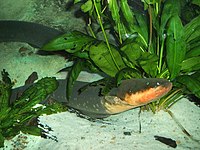
Clove oil induces anaesthesia and blunts muscle contraction power in three Amazon fish species
Sign Up to like & getrecommendations! Published in 2017 at "Fish Physiology and Biochemistry"
DOI: 10.1007/s10695-017-0430-8
Abstract: Clove oil is used as an anaesthetic for many species of fish worldwide; however, relatively few studies have assessed its effectiveness on Amazon fish species and no compelling evidence has ever been reported on the… read more here.
Keywords: amazon fish; fish species; muscle contraction; three amazon ... See more keywords

Crosstalk between developing vasculature and optogenetically engineered skeletal muscle improves muscle contraction and angiogenesis.
Sign Up to like & getrecommendations! Published in 2018 at "Biomaterials"
DOI: 10.1016/j.biomaterials.2017.11.041
Abstract: Capillary networks surrounding skeletal muscle play an important role in not only supplying oxygen and nutrients but also in regulating the myogenesis and repair of skeletal muscle tissues. Herein, we model the early stages of… read more here.
Keywords: skeletal muscle; angiogenesis; muscle; muscle fiber ... See more keywords

Muscle Contraction-Inspired Tough Hydrogels.
Sign Up to like & getrecommendations! Published in 2023 at "ACS applied materials & interfaces"
DOI: 10.1021/acsami.2c20319
Abstract: In many animals, tough skeletal muscle contraction occurs, producing a strong force through myofilaments attaching to and sliding on fibrous actin filaments. In contrast, the strength of typical synthetic hydrogels is facilitated mainly by polymeric… read more here.
Keywords: contraction inspired; tough hydrogels; muscle contraction; inspired tough ... See more keywords

Indices reflecting muscle contraction performance during exercise based on a combined electromyography and mechanomyography approach
Sign Up to like & getrecommendations! Published in 2021 at "Scientific Reports"
DOI: 10.1038/s41598-021-00671-2
Abstract: Electromyography (EMG) and mechanomyography (MMG) have been used to directly evaluate muscle function through the electromechanical aspect of muscle contraction. The purpose of this study was to establish new absolute indices to describe muscle contraction… read more here.
Keywords: contraction performance; muscle; muscle contraction; emg ... See more keywords

Trans-ε-viniferin as an inhibitor of TMEM16A preventing intestinal smooth muscle contraction.
Sign Up to like & getrecommendations! Published in 2023 at "Journal of Asian natural products research"
DOI: 10.1080/10286020.2023.2165067
Abstract: TMEM16A regulator is an important tool to study the physiological functions and pathogenesis related to TMEM16A. In the present study, trans-ε-viniferin (TV) was identified as a TMEM16A inhibitor with inhibitory activity against TMEM16A mediated Cl-… read more here.
Keywords: intestinal smooth; trans viniferin; muscle contraction; inhibitor ... See more keywords

Task-dependent recruitment across ankle extensor muscles and between mechanical demands is driven by the metabolic cost of muscle contraction
Sign Up to like & getrecommendations! Published in 2021 at "Journal of the Royal Society Interface"
DOI: 10.1098/rsif.2020.0765
Abstract: The nervous system is faced with numerous strategies for recruiting a large number of motor units within and among muscle synergists to produce and control body movement. This is challenging, considering multiple combinations of motor… read more here.
Keywords: cost muscle; muscle; recruitment; metabolic cost ... See more keywords

Structural Biochemistry of Muscle Contraction.
Sign Up to like & getrecommendations! Published in 2023 at "Annual review of biochemistry"
DOI: 10.1146/annurev-biochem-052521-042909
Abstract: Muscles are essential for movement and heart function. Contraction and relaxation of muscles relies on the sliding of two types of filaments-the thin filament and the thick myosin filament. The thin filament is composed mainly… read more here.
Keywords: structural biochemistry; biochemistry muscle; muscle; muscle contraction ... See more keywords

Exploring Key Genes and Pathways of Cardiac Hypertrophy Based on Bioinformatics
Sign Up to like & getrecommendations! Published in 2022 at "Disease Markers"
DOI: 10.1155/2022/2081590
Abstract: Objective This research is aimed at identifying the key genes and pathways of cardiac hypertrophy using bioinformatics and at providing a new target for the identification of cardiac hypertrophy. Methods Microarray data GSE1621 and GSE18801… read more here.
Keywords: key genes; hypertrophy; muscle contraction; cardiac hypertrophy ... See more keywords

A case of severe pseudohyperkalaemia due to muscle contraction
Sign Up to like & getrecommendations! Published in 2020 at "Biochemia Medica"
DOI: 10.11613/bm.2020.021004
Abstract: Introduction Severe hyperkalaemia is a serious medical condition requiring immediate medical attention. Before medical treatment is started, pseudohyperkalaemia has to be ruled out. Case description A 10-month old infant presented to the emergency department with… read more here.
Keywords: muscle; case; pseudohyperkalaemia; hyperkalaemia ... See more keywords

Differences of muscle co-contraction of the ankle joint between young and elderly adults during dynamic postural control at different speeds
Sign Up to like & getrecommendations! Published in 2017 at "Journal of Physiological Anthropology"
DOI: 10.1186/s40101-017-0149-3
Abstract: BackgroundAgonist and antagonist muscle co-contractions during motor tasks are greater in the elderly than in young adults. During normal walking, muscle co-contraction increases with gait speed in young adults, but not in elderly adults. However,… read more here.
Keywords: ankle joint; muscle; speed; dynamic postural ... See more keywords

Muscle co-contraction in elderly people change due to postural stability during single-leg standing
Sign Up to like & getrecommendations! Published in 2017 at "Journal of Physiological Anthropology"
DOI: 10.1186/s40101-017-0159-1
Abstract: BackgroundMuscle co-contraction is the simultaneous contraction of agonist and antagonist muscles crossing a joint, and it increases with age. This study primarily aimed to clarify the difference in the effect of a light fingertip contact… read more here.
Keywords: fingertip contact; condition; contraction; muscle contraction ... See more keywords